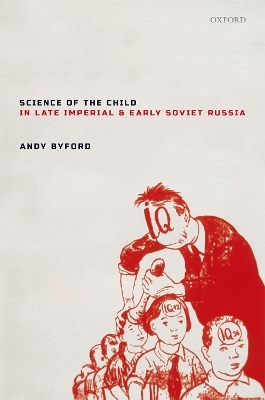
Science of the Child in Late Imperial and Early Soviet Russia
Seiten
2020
Oxford University Press (Verlag)
978-0-19-882505-0 (ISBN)
Oxford University Press (Verlag)
978-0-19-882505-0 (ISBN)
From the 1880s to the 1930s, children became the focus of unprecedented scientific and professional interest in modernizing societies worldwide. Science of the Child charts the rise and fall of the interdisciplinary field devoted to the study of children across the late Imperial and early Soviet eras.
Between the 1880s and the 1930s, children became the focus of unprecedented scientific and professional interest in modernizing societies worldwide, including in the Russian Empire and then the Soviet Union. Those who claimed children as special objects of investigation were initially spread across a network of imperfectly professionalized scholarly and occupational groups based mostly in the fields of medicine, education, and psychology. From their various perspectives, they made ambitious claims about the contributions that their emergent expertise made to the understanding of, and intervention in, human bio-psycho-social development. The international movement that arose out of this catalyzed the institutionalization of new domains of knowledge, including developmental and educational psychology, special needs education, and child psychiatry.
Science of the Child charts the evolution of the child science movement in Russia from the Crimean War to the Second World War. It is the first comprehensive history in English of the rise and fall of this multidisciplinary field across the late Imperial and Soviet periods. Drawing on ideas and concepts emanating from a variety of theoretical domains, the study provides new insights into the concerns of Russia's professional intelligentsia with matters of biosocial reproduction and investigates the incorporation of scientific knowledge and professional expertise focused on child development into the making of the welfare/warfare state in the rapidly changing political landscape of the early Soviet era.
Between the 1880s and the 1930s, children became the focus of unprecedented scientific and professional interest in modernizing societies worldwide, including in the Russian Empire and then the Soviet Union. Those who claimed children as special objects of investigation were initially spread across a network of imperfectly professionalized scholarly and occupational groups based mostly in the fields of medicine, education, and psychology. From their various perspectives, they made ambitious claims about the contributions that their emergent expertise made to the understanding of, and intervention in, human bio-psycho-social development. The international movement that arose out of this catalyzed the institutionalization of new domains of knowledge, including developmental and educational psychology, special needs education, and child psychiatry.
Science of the Child charts the evolution of the child science movement in Russia from the Crimean War to the Second World War. It is the first comprehensive history in English of the rise and fall of this multidisciplinary field across the late Imperial and Soviet periods. Drawing on ideas and concepts emanating from a variety of theoretical domains, the study provides new insights into the concerns of Russia's professional intelligentsia with matters of biosocial reproduction and investigates the incorporation of scientific knowledge and professional expertise focused on child development into the making of the welfare/warfare state in the rapidly changing political landscape of the early Soviet era.
Andy Byford is Professor of Russian at Durham University. He has published extensively on the history of the humanities academia, human sciences, medicine, education, and related professions in late Imperial and early Soviet Russia.
1: Introduction: Sciences of the Child in Transnational Perspective
2: The Upbringing of Man: Of Nurture and Nature
3: Pedagogy as Science: Across Disciplines and Professions
4: The Imperfect Child: Between Diagnostics and Therapeutics
5: Child Science in Revolution: From Trauma to Transformation
6: The Making of Pedology: Science and the State
7: Pedology at Work: Instrument and Occupation
8: Conclusion: The Afterlife of a 'Repressed Science'
| Erscheinungsdatum | 03.01.2020 |
|---|---|
| Zusatzinfo | 14 black and white figures/illustrations |
| Verlagsort | Oxford |
| Sprache | englisch |
| Maße | 161 x 240 mm |
| Gewicht | 654 g |
| Themenwelt | Geschichte ► Allgemeine Geschichte ► Neuzeit (bis 1918) |
| Geisteswissenschaften ► Geschichte ► Regional- / Ländergeschichte | |
| Sozialwissenschaften ► Pädagogik ► Allgemeines / Lexika | |
| ISBN-10 | 0-19-882505-6 / 0198825056 |
| ISBN-13 | 978-0-19-882505-0 / 9780198825050 |
| Zustand | Neuware |
| Haben Sie eine Frage zum Produkt? |
Mehr entdecken
aus dem Bereich
aus dem Bereich
Giordano Bruno - ein ketzerisches Leben
Buch | Hardcover (2024)
C.H.Beck (Verlag)
CHF 41,85
das dramatische 16. Jahrhundert
Buch | Hardcover (2024)
Rowohlt Berlin (Verlag)
CHF 47,60


